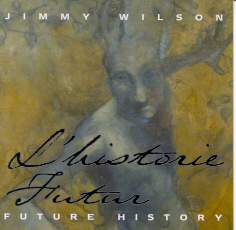Jimmy
Wilson - Future History
 I
don't remember exactly the time, when I heard about Jimmy
Wilson the first time. May be I listened to his trumpet on Slim Man's
"Secret Rendezvous" (1997). He also played the flugelhorn on
Grainger's "Phase I" (1997). I recently reviewed Grainger
"Phase II". Jimmy's
first album "Identity" was published on the Replicant label in
1996. Replicant
Records and Recording started as a result of so many recording
artists not having control of their own music in an ever-changing world. This company is connected with GBM
Records. I mention these companies because of their honorable
efforts to support independent artists of contemporary jazz, which are
partly beyond the typical Smooth Jazz scene.
I
don't remember exactly the time, when I heard about Jimmy
Wilson the first time. May be I listened to his trumpet on Slim Man's
"Secret Rendezvous" (1997). He also played the flugelhorn on
Grainger's "Phase I" (1997). I recently reviewed Grainger
"Phase II". Jimmy's
first album "Identity" was published on the Replicant label in
1996. Replicant
Records and Recording started as a result of so many recording
artists not having control of their own music in an ever-changing world. This company is connected with GBM
Records. I mention these companies because of their honorable
efforts to support independent artists of contemporary jazz, which are
partly beyond the typical Smooth Jazz scene.
Jimmy Wilson's second album
"Future History" is a concept album, a "montage of
modern life". Each track on this album tells its own story. Jimmy
melts the style of Lee Morgan, Clifford Brown and Miles to his unique
sound experience.
The albums starts with Super
Hero. Jimmy
describes this figure as "a fictitious comic book character on
a mission of civility and love". The tune sounds like a movie
score, combining classic instruments as violin, viola, cello and
Kathleen Stapelton's soprano vocals with modern electronic sounds,
drums, percussion, bass, guitar and Jimmy's muted trumpet. I call it
an "opus", to give you an imagination of its mighty
variations. In the middle of the piece Jimmy brilliants with some
neo-modern jazz elements.
From there in Apparitions,
our Super Hero is being waylaid by the forces of evil in the form of a
beautiful temptress. This piece contains a spoken dialogue between
a man and a woman, enriched with a score like melodic addition.
Scott Ambush shows his energetic bass.
Next Aaron Copeland speaks and
introduces the title cut, Future History.
Jimmy's trumpet grows to a monumental dimension.
Restless
Intonation combines N'dinga Gaba's turntables with horn arrangements to a
spectacular soundscape. Gary Thomas plays the sax and Dennis Chambers
takes over the propulsive drums part. A similarity to John McLaughlin's
music is obvious.
The Ear
of the Beholder unfolds a sad tale of man's inhumanity and
world hostility unfolds. Jimmy develops anew a soundscape of
rhythm signals, muted trumpet and flugelhorn. Even a didgeridoo (an
Australian instrument of the aborigines) is played by Troy Straszheim.
Following in Fortune
Teller, our Super Hero deciphers a message. Jimmy takes the
further step to jazz fusion.
Love
Mission finds our Hero accepting all responsibility for his
odyssey. French spoken words introduce Jimmy's next jazz fusion
creation which change to a conglomerate of world music, African rhythms
and finally to Mark Wood's explosion of electric violin. A voyage to
new sound experiences steadily driven by Chester Thompson's fuliminant
drums play.
In Cirque
his mission is accomplished and everyone rejoices. Gerald
Veasley's bass is just one of the artists which are creating a work,
which cannot be described with words. Unique, original, not
comparable.
In Dreams
our Hero asks the question, "Was this adventure real or
imagined?" Jimmy experiences with rhythms, sounds and melody
fragments developing sound-paintings of superiors quality.
I understand Jimmy Wilson's album
"Future History" as an epic work comparable for example with
Mussorky's "Pictures at an Exhibition" for piano (1874). The
tightness of the playing of all artists mediates us a new sound-experience,
never heard before.


